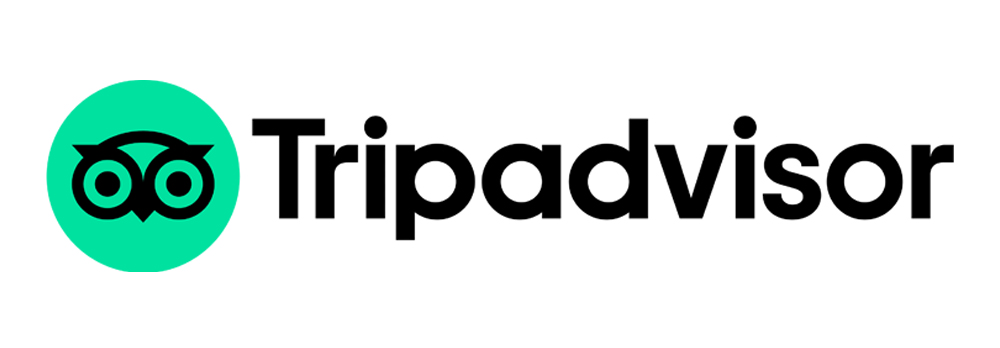Nepal is one of the best destinations for trekking as its wild areas of upper and lower Himalayan regions have been always fascinating spots for adventurers. And those who want to explore the formation of the Indian Subcontinent also visit this beautiful Himalayan Country.
Indeed, the first commercial trekking in Nepal was organized by Col Zimmy Robert in the 1960s. Since then, thousands of adventure lovers have visited Nepal only for trekking its mountain areas. It is obvious that thousands of adventure seekers visit Nepal to enjoy the high mountains with their flora and fauna. For those people, trekking is the best activity to touch the Himalayas. There are many trekking trails in Nepal while Everest Base Camp Trek and Annapurna Circuit Trek are two major destinations that the trekkers want to go to primarily. In this article, I am going to give you detailed information about trekking in Nepal which can help you to build the perfect holiday plan for trekking in Nepal.
How to get a Nepalese Visa
The initial consideration of a travel plan abroad always should be visa acceptance. So you need to consider taking of Nepali visa. Likewise, Nepal also provides arrival travel visas to the citizen of most countries. On arrival, the visa can be obtained through Tribhuvan International Airport and border points of India and China (Nepal – India borders: Kakadbhitta, Birgunj, Bhairahawa, Nepalgunj, and Gaddachowki | Nepal – China border: Kodari). In order to get the visa online, you can submit your application through the official immigration website of the Nepal government. In addition, the visa can be also obtained from your nearest Nepal embassy or diplomatic mission.
What currency does Nepal accept?
The Nepalese rupee is the official currency in Nepal. Its current exchange rate is above Rs 110 for $1 USD. You can directly exchange your money in several money exchange centers in Kathmandu and Pokhara cities. Otherwise, you can go to the bank to exchange your money. But only major currencies like the US dollar, Canadian Dollar, Euro, British Pound, Australian Dollar, Japanese Yen, etc are exchanged. In addition, some of the hotels and trekking agencies also accept US dollars and British Pound.
There are ATMs in most cities in Nepal that accepts international cards but charge approximately Rs 400 for each transaction.
When you are going to trek in the mountains of Nepal, you need to withdraw enough cash from ATMs as there may not be cash in the ATMs somewhere on the routes. You can see ATMs in Lukla and Namche of Everest and Jomsom and Besisahar of Annapurna circuit.
What is the best time for trekking in Nepal
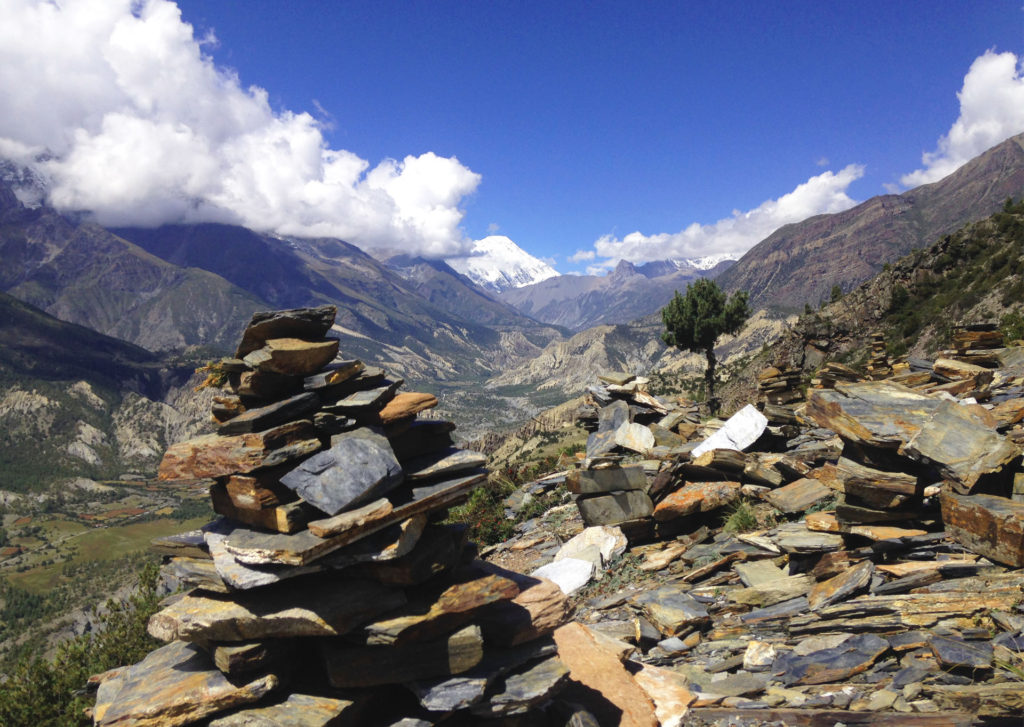
Basically, Nepal has four seasons: Spring (March, April, and May), Summer (June, July, and August), Winter (December, January, and February), and Autumn (September, October, and November). Among all these seasons, Spring and Autumn are the best seasons for trekking in Nepal. Therefore, most trekkers schedule their time either in the spring or autumn to travel to Nepal. Monsoon or summer is the worse season for hiking in Nepal because heavy raining causes landslides and floods that made trekking risky at that time.
If you don’t want crowds on your trekking trails, then you can choose the winter season. You will encounter fewer trekkers in the winter season. I personally suggest short treks like Mardi Himal Trek, Khopra Trek, Langtang Valley Trek, etc in this season. If you go for a high or long trek like Everest Three Pass or Annapurna Circuit, the risk of avalanches will be high or you may fail to find the trail because of the heavy snowfall over the routes.
To get detailed information on the best seasons to travel to Nepal, click here.
Trekking Permits
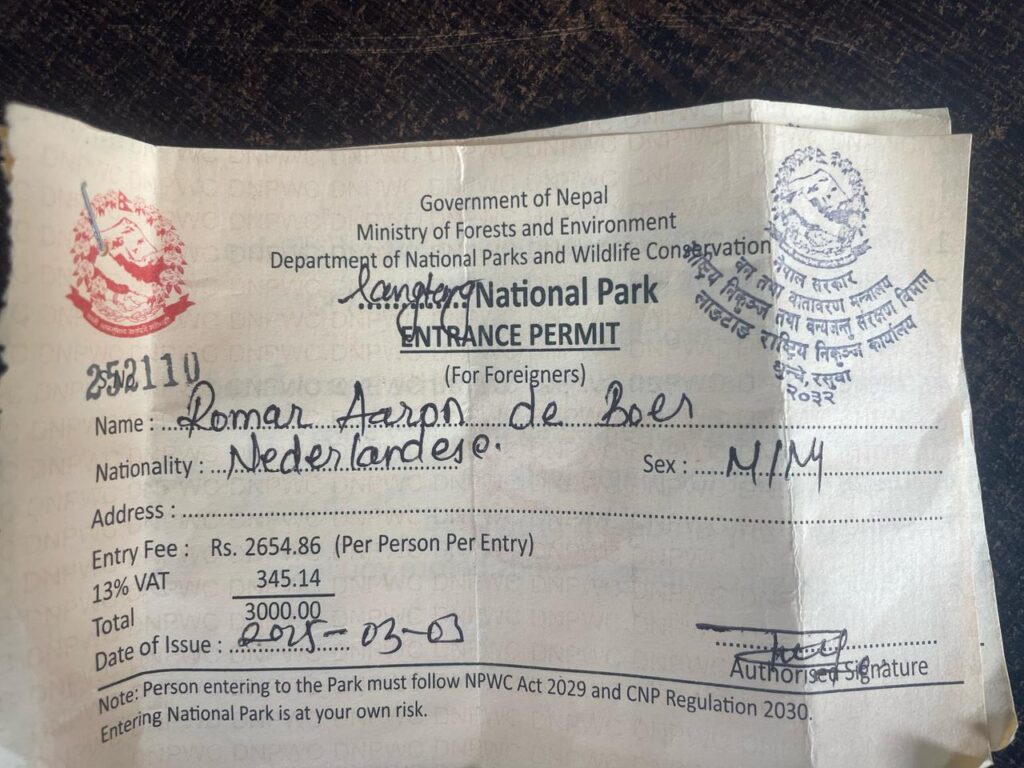
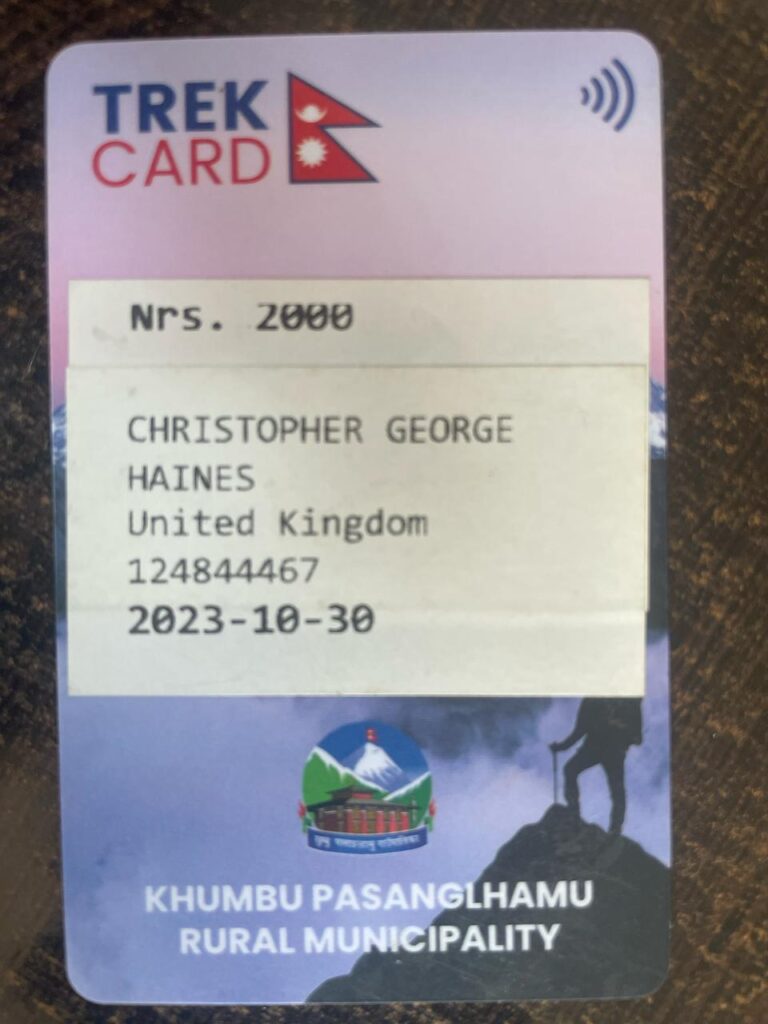
Basically, you need TIMs card in most of the trails. And National Park Permit is also necessary to have if you are walking inside any of the national park areas like Sagarmatha National Park, Manaslu Conservation Area, Gaurishankar Conservation Area, Annapurna Conservation Area, Dhorpatan Conservation Area, etc.
In order to obtain all these permits, you should bring a copy of your valid passport and pp size photo of yourself.
The cost of TIMs card is Rs 2000 for an individual trekker. But if you are in a group, then it costs Rs 1000 per person. Similarly, National Park Permit costs Rs 3200 per person.
Costing of Trekking in Nepal
To find out the cost of trekking in Nepal, you need to break down the amount of each of the following:
- Guide and Porter
- Foods and Accommodation
- Permits
- Tips for guide and porter
- Drinking water
- Miscellaneous things
To hire a guide in Nepal costs nearly $30 – $45 USD per day while a porter costs $20 – $25 per day.
The basic food in the trail of Nepal is Dal Bhat while you can choose varieties of food items like Momos, Spaghettis, etc. In my opinion, $25 is enough to have 3 times meals per day on the mountain trail of Nepal.
Teahouse is the accommodation in most of the trails in Nepal. If you are an individual trekker, then it is obvious you need to pay for accommodation that may cost from Rs 500 to Rs 1000 for a bed. I am saying bed here because single rooms may not be available in most of the trekking areas.
Don’t drink the natural water in trekking areas without purifying it. You can take a water purifier and then drink the water. If you want to buy mineral water in the teahouse, it costs 4-5 times more expensive than in Kathmandu. A bottle of mineral water costs from Rs 100 – Rs 300.
Alcoholic items are expensive in Nepal. For a bottle of beer, you pay around $7 USD here in Nepal.
In most of the teahouses, you need to pay for WIFI service, battery charging, etc. They will take you approximately $1 for each of those facilities.
Note: I have written an article to guide you about the estimation of Everest Base Camp Trek Cost.
Trekking Insurance
You have to buy trekking insurance while you are trekking in Nepal. And your trekking insurance must cover emergency helicopter evacuation and medical and repatriation. Unfortunately, there are chances of Acute Mountain Sickness as you will be walking above 4000 m – 5000 m in height. So the oxygen level of this area is apparently in the low stage.
Accommodation in the Trekking
None of the star hotels can be found in the trekking; trekkers should stay either in teahouses or in camping. Most of the trekking routes of Nepal offer teahouse accommodation and those trails are known as teahouse trekking. Some of the most popular routes like Everest Base Camp Trek and Annapurna Circuit Trek have good facilities and infrastructures in the teahouses while off-beaten track teahouses deliver basic services like food and lodging only. In most the teahouses, there is a facility for electricity but you need to pay extra for charging the hot shower, and WIFI, etc services. Furthermore, only some teahouses do have western-style attached toilets, otherwise, you need to use an outside settle toilet.
The price of accommodation depends upon trails and seasons even different teahouses have their own price range. Usually, you will pay Rs 500 rupee i.e $4.5 USD approx for two people. Besides that, in some tea houses, accommodation cost compromises the price of meals.
Most of the teahouse owners believe that you will have meals i.e arrival day’s dinner and leaving day’s breakfast in their teahouses. So, they charge trekkers such a low amount for accommodation. Well, if you don’t want to have a meal at the same teahouse, then the price may rise up to Rs 1500. Therefore, I can only suggest to you pay the minimum for accommodation and spend more on your meals.
Foods on the Trekking
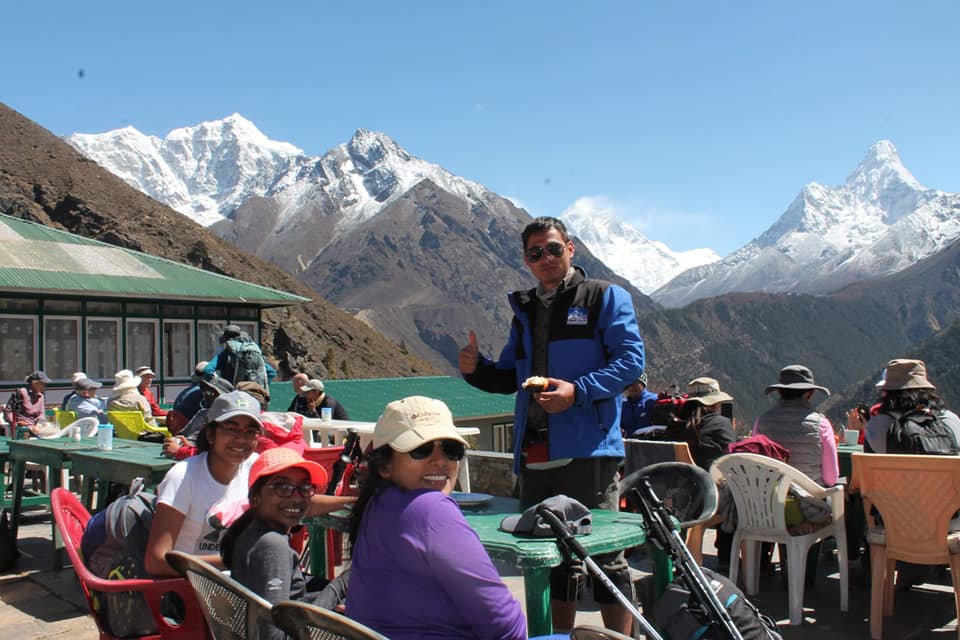
You will be surprised by the wide variety of food menu in Everest Base Camp Trek and Annapurna Circuit and Base Camp but you will be usually served Dal Bhat, Maggie (Noodles), or limited to rice dishes.
Local cuisines of Nepal are Dal Bhat, Tibetan bread, Momos, and Yak cheese/Yak Burger. Among all these Dal Bhat is the best-valued food in trekking. Basically, it is served endlessly. When your plate is empty, they keep filling it until you say “Malai Pugyo !” i.e it is enough for me.
Drinking Water in Trails
As I have already mentioned, you don’t want to drink stream water from the trails without using a water purifier. Or you can buy mineral water in the teahouses but costs 2 times higher than in Kathmandu. In addition, you can also buy boiled water that normally costs Rs 200 – Rs 300 per thermos.
Remember that you should be always hydrated as the trails go over 3000m – 5000m above where the oxygen level is less than normal.
Trekking Gears
Trekking gears are needed on the trails, and you can either bring them from your home country or rent/buy them in Kathmandu, Nepal. You can find many trekking gear shops around Thamel, Kathmandu but should be aware before dealing with them. It is better if you can bargain with them, but I don’t suggest to irritatingly discussing it with them. 🙂
You should bring more essential gear like hiking boots, a sleeping bag, a down jacket, hiking sticks, etc. If you want one-time use of these gears, then either you can buy cheap gears or rent them. To get more detail about the gears, you can check our trekking gear checklist article.
10 Best Treks in Nepal
There are many trekking trails in Nepal. All those trails are beautiful and you will not forget that trekking after you visit there. Among them, some trails have been most popular due to their easy accessibility and best landscape mountain views, local ethnic culture, etc.
Before you plan your trekking in Nepal, you should choose which trek you want to do. Because the country is the Himalayan Kingdom, situated between two giants – China and India, there are many trekking routes in Nepal. All the trekking routes of Nepal are on the northern side which is better known as the mountain region of Nepal. So, here we have listed the top 10 best trekking in Nepal that you may like to plan for doing in the future. We have researched the popularity, feasibility of trekking, difficulty, panoramic view, cultural aspect, etc of all these trekking routes before ordering them from 1 to 10.
Everest Base Camp Trek
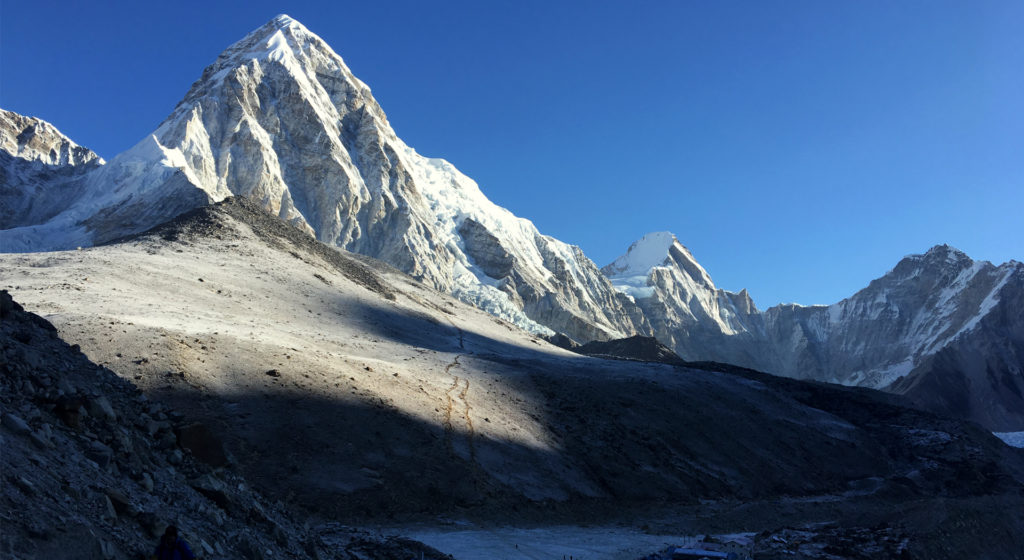
Everest Base Camp Trek is always the number one trekking in Nepal. Many travelers say that it is the world’s no 1 trekking route. Anyway, it definitely comes to the top 5 list of the best trekking in the world. There are some reasons behind the popularity of this trek among adventurers. The first and inevitable reason is that it goes very closer to Mt. Everest (8848 m) – it is the world’s highest mountain. Most travelers choose the Everest base camp trek just to view mount Everest from closer. Therefore, we have included the Everest base camp trek in the list of the top 10 best trekking in Nepal.
Another reason is that the Everest base camp trek follows Hillary’s footprints who is a legendary mountaineer. Tenzing Norgay and Edmund Hillary made their path to the summit of Mount Everest from this way; now it is a route of EBC Trek.
The trek passes through a few beautiful Sherpa villages and suspension bridges over the Dhudhkosi river along with a renowned sherpa village Namche Bazaar – also known as the gateway of Mount Everest.
Check out 5 ultimate best itineraries for Everest Base Camp Trek
Overview
| Maximum Elevation | 5545 m, Kalapathar |
| Trekking Difficulty | Moderate |
| Duration | Min. 11 Days |
| Best Time | March to May and September to November |
| Accommodation Type | Tea House (Twin shared/Dormitory) |
| Required Permits | TIMs, Sagarmatha National Park Entry Permit, Local Government charge |
| Restricted Permits | Not required |
| Transportation | Kathmandu-Lukla-Kathmandu domestic flight |
| Route | Lukla – Phakding – Namche – Tengboche – Dingboche – Lobuche – Gorakshep – EBC |
Annapurna Circuit Trek
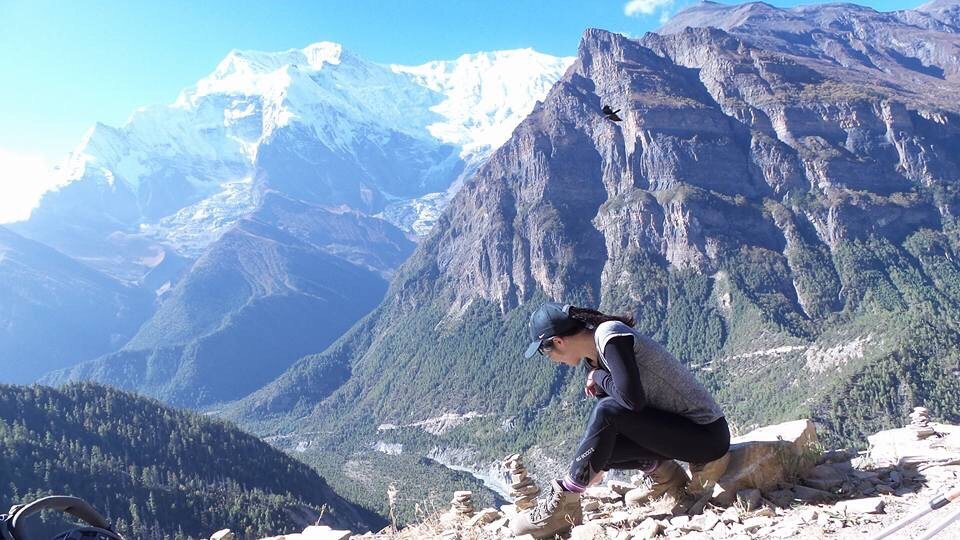
Annapurna Circuit Trek has gained popularity for its stunning panoramic views. It passes through various landscapes in the Annapurna region and offers travelers to explore the rich culture and geographical diversity of the region.
The classic route of Annapurna Circuit Trek begins from Besisahar. Due to the road construction, now you can directly reach Chame village by private vehicle. However, its charm and beauty are still intact and its popularity has not decreased.
You walk through the jungle to alpine and lush forest, charming villages, and drained peak that allows soft acclimatization to you.
Hence it is considered to be one of the best trekking in Nepal.
Overview
| Maximum Elevation | 5416 m Thorong La Pass |
| Trekking Difficulty | Moderate |
| Duration | Min. 7 Days |
| Best Time | March to May and September to November |
| Accommodation Type | Tea house (Twin shared / dormitory) |
| Required Permits | TIMs and Annapurna Conservation Area Permit |
| Restricted Permit | Not required |
| Transportation | Bus/Private Vehicle (To reach Besisahar or Chame) |
| Route | Chame – Pisang – Manang – Thorong Phedi – Muktinath – Kagbeni – Pokhara |
Manaslu Circuit Trek
Manaslu Circuit Trek is a restricted area trek that belongs to the Manaslu region. In recent days, it is gaining more popularity among trekkers who want to explore unique cultures and traditions. The trek passes through some ethnic communities whose origin is from Tibet. On the other hand, trekkers will get the opportunity to go to the Manaslu Base Camp (4800 m) and closer to Nepal – Tibet border.
This trek encircles Mt. Manaslu (8163 m) which is the world’s 8th highest mountain, located in the Mansiri Himal range.
Foreigners’ visit to Manaslu was forbidden until 1991 because Tibet access is very easy from the Samdo village of Manaslu. But now, the Nepal Government has opened it to all foreigners. However, it is still a restricted area since it requires a special permit to visit the region. Moreover, you can not make your solo trip to Manaslu as it requires at least 2 trekkers to get special permission to visit Manaslu. To get a special permit, you must go through a government-licensed trekking agency.
For your kind information, here we have designed a guideline to find the best trekking agency in Nepal.
Overview
| Maximum Elevation | 5160 m Larkya Pass |
| Trekking Difficulty | Moderate |
| Duration | Min. 13 Days |
| Best Time | March to May and September to November |
| Accommodation Type | Tea house (Twin shared / dormitory) |
| Required Permits | TIMs, Manaslu Conservation Area Permit, Annapurna Conservation Area Permit, and Special Permit |
| Restricted Permit | Required |
| Transportation | Private Vehicle to reach Sotikhola |
| Route | Arughat – Soti Khola – Machha Khola – Jagat – Deng – Namrung – Samagaon – Samdo – Dharmasala – Bhimtang – Tilije – Tal – Syanje |
Annapurna Base Camp Trek
After Annapurna Circuit Trek, Annapurna Base Camp Trek is the second most renowned trekking route in Annapurna Region. It brings you to the face-to-face of an eight-thousander – Mt. Annapurna (8091 m) – it is the 10th highest mountain in the world. As the Everest Base Camp Trek, it is also a moderate trek. The view of Annapurna is really incredible from its base camp which offers a surrounding panoramic view of the mountains. And according to the survey, it has the highest fatality ratio among the rest of the mountains which belongs to eight-thousanders.
The trek starts from Pokhara and goes away 64 miles long which takes nearly 10 days. Specially, you will enjoy the distinct view of the mountains like Himchuli, Machhapuchre, and Annapurna while you reach Ghandruk – it is a small Gurung village situated on the lap of Machhapuchhre. It passes through other villages – Komorong, Chomorong, Dhovan, Bamboo, etc. with beautiful mountain views as well as an exploration of Gurung ethnicity.
This trek is therefore popular among hikers because the approach to Annapurna base camp is easier than EBC and Annapurna Circuit. It does not require any air transportation to begin the trek like the EBC trek. The beauty of this trek is its proximity to Pokhara city. That is why hikers can easily decide to begin the Annapurna base camp trekking.
Overview
| Maximum Altitude | 4130 m at Annapurna Base Camp |
| Trekking Difficulty | Moderate |
| Duration | 10 Days |
| Best Time | March to May and September to November |
| Accommodation Type | Tea house (Twin shared / dormitory) |
| Required Permits | TIMs and Annapurna Conservation Area Permit |
| Restricted Permit | Not required |
| Transportation | Kathmandu to Pokhara Bus/Car or Flight to Nayapul Private Vehicle |
| Route | Chame – Pisang – Manang – Thorong – Muktinath – Kagbeni – Jomsom |
Langtang Valley Trek
The Langtang Valley Trek is the nearest trek from Kathmandu, and it is popular for its wide views and Tamang culture. The valley had been badly affected by the subsequent landslides of the 2015’s earthquake. But, with the help of national and international levels, it was opened very soon. Moreover, still, the region is as charming as it used to be. Your visit to Langtang will also help with the livelihoods of the local residents.
In recent days, people of this valley are rebuilding their houses and trying to live as happily as they seemed to be before the quake.
This trek starts from Besisahar and you will walk through lush forests to the high alpine meadows till reaching Yak grazing land around Kyanjin Gompa (3800 m).
Overview
| Maximum Elevation | 4773 m Kyanjin Ri |
| Trekking Difficulty | Moderate |
| Duration | Min. 7 Days |
| Best Time | March to May and September to November |
| Accommodation Type | Tea house (Twin shared / dormitory) |
| Required Permits | TIMs and Langtang National Park Permit |
| Restricted Permit | Not required |
| Transportation | Kathmandu to Syaprubeshi – either bus or private vehicle |
| Route | Syaprubeshi – Lama Hotel – Langtang Village – Kyanjin Gompa |
Ghorepani Poonhill Trek
Ghorepani Poonhill Trek is a short trek that can be approached in 3 days from Pokhara. Poonhill is situated at 3210 meters above sea level. It is popular for the breathtaking sunrise view and closes up to the panorama of mountains – Dhaulagiri (8167 m), Annapurna I (8091), and Manaslu (8163 m).
Ghorepani Poonhill Trek is an easy trek. So, it does not require a high level of fitness in order to hike to Ghorepani Poonhill; hence there is no real risk.
Those who make their frequent visit to Nepal, do not suppose to need a guide to trek in Ghorepani Poonhill. However, if it is your first visit to Nepal and Ghorepani, then we suggest you hire at least a guide cum porter. S/he will guide your paths to trek and help you to find out a good tea house for an overnight stay.
| Maximum Elevation | 3210 m Poonhill |
| Trekking Difficulty | Easy |
| Duration | Min. 3 Days |
| Best Time | March to May and September to November |
| Accommodation Type | Tea house (Twin shared) |
| Required Permits | TIMs and Annapurna Conservation Area Permit |
| Restricted Permit | Not required |
| Transportation | Kathmandu to Pokhara bus/flight and Pokhara to Nayapul Private vehicle |
| Route | Pokhara – Nayapul – Ulleri – Ghorepani |
Upper Mustang Trek
Upper Mustang Trek offers unique geographic views and unique culture. On the other hand, Upper Mustang is also portraying the natural and cultural diversity of Nepal. It is the only land of Nepal that lies behind the Himalayas. Its geographical structure is the same as Tibet, and you also found the similarity in culture and tradition.
Tiji – a colorful festival, is an auspicious festival celebrated around Upper Mustang in the third month of the Tibetan calendar (May). It was started in the 17th century by King Samdup Rabten. Since then, this holy dance has been performed by the monks of Chhode Monastery each year.
Nowadays, Upper Mustang is accessible by driving as there has been road construction. However, the road is not fully concreted, but you can enjoy it by jeep trip. And it is being popular in recent days indeed.
Overview
| Maximum Altitude | 3810 m Drakmar |
| Trekking Difficulty | Moderate |
| Duration | Min. 10 Days |
| Best Time | March to May and September to November |
| Accommodation Type | Tea house (Twin shared) |
| Required Permits | TIMs, Annapurna Conservation Area Permit, and Special Permit |
| Restricted Permit | Required |
| Transportation | Kathmandu to Pokhara bus/flight and Pokhara to Jomsom bus/flight |
| Route | Jomsom – Kangbeni – Chele – Geiling – Charang – Lo Manthang – Dakamar |
Kanchenjunga Trek
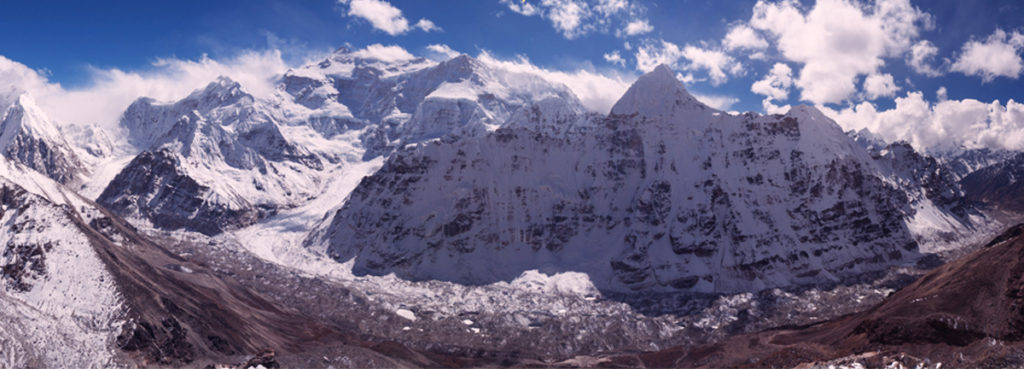
Kanchenjunga Trek is a virgin trek as the trail is still unexplored and is located in the eastern part of Nepal. Throughout the trekking, you can see a wonderful view of the Mahalangur Himalaya range (Mt. Everest 8848 m, Mt. Makalu 8201 m, Mt. Lhotse 8516 m) and Mt. Kanchenjunga (8586 m).
The variety of landscapes of the Kanchenjunga region is incredibly unique and there is massive wildlife in the region. The region is the habitat of musk deer, red pandas, snow leopards, etc like wild animals. In addition, an imaginary snowman is believed to have been found in the remote Himalayas of this region.
Overview
| Maximum Altitude | 5140 m Kanchenjunga Base Camp |
| Trekking Difficulty | Moderate |
| Duration | Min. 19 Days |
| Best Time | March to May and September to November |
| Accommodation Type | Tea house (Twin shared) |
| Required Permits | TIMs, Kanchenjunga National Park Permit, and Special Permit |
| Restricted Permit | Required |
| Transportation | Kathmandu to Suketar Domestic Flight |
| Route | Basantapur – Chauki – Gupa Pokhari – Nesum – Gorgagoan – Thumma – Chirwa – Sakathum – Amjilosa – Gyabla – Gunsa – Khambachen – Lhonak – Pangpema – Khangpachen – Lumba Samba – Ramche – Cheram – Tortong – Yamphudin – Anpan – Tembewa |
Everest Three High Passes Trek
Everest Three High Passes Trek is the second most popular trek in the Everest region just behind the EBC trek. It is arguably the most complete trek in the Everest region as it covers most of the parts of the region. The trek is physically challenging trek as it goes through 3 high passes – Renjo La Pass (5370 m), Chola Pass (5420 m), and Kongma La Pass (5535 m). In addition, the trail has even stretched across the Gokyo valley, Everest base camp (5384 m), and Kalapathar (5545 m). So you need to be physically and mentally fit to endeavor Everest three high passes trek.
Overview
| Maximum Altitude | 5545 m Kalapathar |
| Trekking Difficulty | Strenuous |
| Duration | Min. 15 Days |
| Best Time | March to May and September to November |
| Accommodation Type | Tea house (Twin shared / Dormitory) |
| Required Permits | TIMs, Sagarmatha National Park Permit, and Local Government Charge |
| Restricted Permit | Not required |
| Transportation | Kathmandu to Lukla Flight |
| Route | Lukla – Phakding – Lukla – Thame – Lungden – Gokyo – Thangna – Zangla – Lobuche – Gorakshep – Chhukung – Pangboche |
Upper Dolpo Trek

Upper Dolpo Trek is also a wonderful trek although it is ordered at the last. It is a camping trek as you hardly get to see tea houses there. The trek begins from Jhuphal after you reach there by domestic flight from Nepalgunj.
Throughout the trail, you will be fascinated by the local people, high Himalayan passes, and the landscape’s views. You will also enjoy the beauty of Phoksundo Lake which is the deepest lake in Nepal.
Overview
| Maximum Altitude | 5090 m Jeng |
| Trekking Difficulty | Moderate to Strenuous |
| Duration | Min. 21 Days |
| Best Time | March to May and September to November |
| Accommodation Type | Tent Camp |
| Required Permits | TIMs, Phoksundo National Park Permit, and Special Permit |
| Restricted Permit | Required |
| Transportation | KTM – Nepalgunj – Juphal domestic flight |
| Route | Juphal – Dunai – Chhepka – Samdua village – Phoksundo Lake – Phoksundo Khola – Bhanjyang – Shey Gompa – Namgung – Sela – Saldang – Chagaon – Rakyo – Darshamna Dovan – Camp – Jyanta Bhanjyang – Murjung – Tokyo Gaun – Jengla – Dho Tarap – Ghyamgar – Tarap Khola – Chhugyar – Tarakot |
Conclusion
As mentioned above all the treks are unique and the best ways to explore the Himalayas. Many of them cross high Himalayan passes and bring you face to face with 8 thousanders.
Indeed, all the above trails can not be put in chronological order because each of them is so important and beautiful in one way. However, many travelers choose Everest Base Camp Trek and Annapurna circuit trek as they are easily accessible and definitely the best trekking routes in the world.






